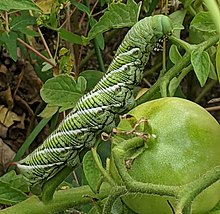
Back مندوكة سداسية Arabic مندوكه سداسيه ARZ Manduca sexta AST Manduca sexta Byelorussian Manduca sexta Bulgarian Manduca sexta CEB Gwalchwyfyn y tomatos Welsh Tabakschwärmer German Manduca sexta Spanish Sphinx du tabac French
| Manduca sexta | |
|---|---|

| |
| Caterpillar | |

| |
| Adult moth | |
| Scientific classification | |
| Domain: | Eukaryota |
| Kingdom: | Animalia |
| Phylum: | Arthropoda |
| Class: | Insecta |
| Order: | Lepidoptera |
| Family: | Sphingidae |
| Genus: | Manduca |
| Species: | M. sexta
|
| Binomial name | |
| Manduca sexta | |
| Synonyms | |
| |
Manduca sexta is a moth of the family Sphingidae present through much of the Americas. The species was first described by Carl Linnaeus in his 1763 Centuria Insectorum.
Commonly known as the Carolina sphinx moth and the tobacco hawk moth (as adults) and the tobacco hornworm and the Goliath worm (as larvae), it is closely related to and often confused with the very similar tomato hornworm (Manduca quinquemaculata); the larvae of both feed on the foliage of various plants of the family Solanaceae. The larvae of these species can be distinguished by their lateral markings: Tomato hornworms have eight V-shaped white markings with no borders; tobacco hornworms have seven white diagonal lines with a black border. Additionally, tobacco hornworms have red horns, while tomato hornworms have dark blue or black horns.[2] A mnemonic to remember the markings is tobacco hornworms have straight white lines like cigarettes, while tomato hornworms have V-shaped markings (as in "vine-ripened" tomatoes). M. sexta has mechanisms for selectively sequestering and secreting the neurotoxin nicotine present in tobacco. [citation needed]
M. sexta is a common model organism, especially in neurobiology, due to its easily accessible nervous system and short life cycle. Due to its immense size M. sexta is big enough for medical imaging modalities (like CT, MRI, or PET) and used as a model in imaging and gut inflammation.[3] It is used in a variety of biomedical and biological scientific experiments. It can be easily raised on a wheat-germ-based diet. The larva is large, and thus it is relatively easy to dissect it and isolate its organs.
- ^ "CATE Creating a Taxonomic eScience – Sphingidae". Cate-sphingidae.org. Archived from the original on November 14, 2012. Retrieved June 16, 2011.
- ^ Villanueva, Raul (June 2009). "Featured Creatures". University of Florida/IFAS. Retrieved October 12, 2012.
- ^
- Asai, Masanori; Li, Yanwen; Newton, Sandra; Robertson, Brian; Langford, Paul (2023). "Galleria mellonella–intracellular bacteria pathogen infection models: the ins and outs". FEMS Microbiology Reviews. 47 (2). Oxford University Press (OUP). doi:10.1093/femsre/fuad011. hdl:10044/1/103485. ISSN 1574-6976. PMC 10045907. PMID 36906279. S2CID 257483883. Federation of European Microbiological Societies (FEMS).
- This review cites this research.
- Windfelder, Anton G.; Müller, Frank H. H.; Mc Larney, Benedict; Hentschel, Michael; Böhringer, Anna Christina; von Bredow, Christoph-Rüdiger; Leinberger, Florian H.; Kampschulte, Marian; Maier, Lorenz; von Bredow, Yvette M.; Flocke, Vera; Merzendorfer, Hans; Krombach, Gabriele A.; Vilcinskas, Andreas; Grimm, Jan (November 24, 2022). "High-throughput screening of caterpillars as a platform to study host–microbe interactions and enteric immunity". Nature Communications. 13 (1): 7216. Bibcode:2022NatCo..13.7216W. doi:10.1038/s41467-022-34865-7. ISSN 2041-1723. PMC 9700799. PMID 36433960.